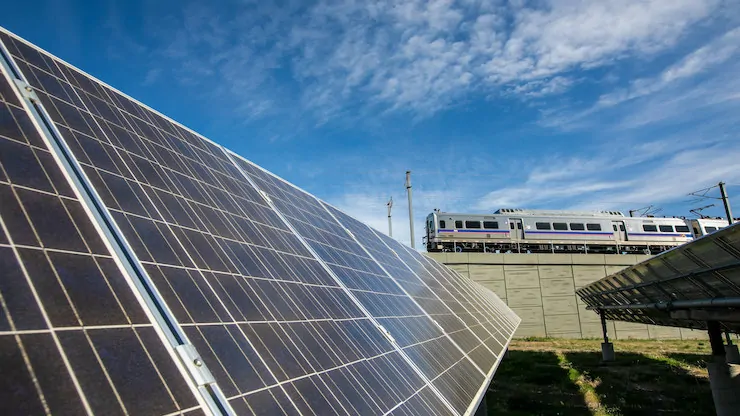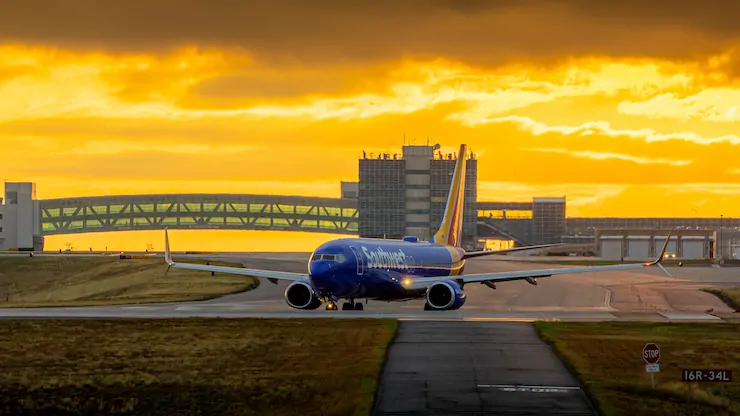Denver airport expects today’s electrical demand of 45 megawatts to expand to 300 to 400 megawatts in the next two decades
by Allen Best
Denver International Airport, which proclaims itself the largest economic hub west of the Mississippi River, has begun investigating whether it can generate its own electricity to meet accelerating needs in the next 20 years.
In doing so, it would lessen or conceivably end dependence on Xcel Energy, its current supplier.
In January, the airport plans to formally post a request for information. It hopes to get proposals for everything from nuclear to geothermal to solar to — well, that is the purpose of this request. The airport, which is owned by the City of Denver, wants to gather ideas, including new ones.
The airport now uses 45 megawatts of electricity, but it sees potential need for 300 to 400 megawatts of electrical generation.
This projected need for 300 to 400 megawatts compares with the peak demand of 295 megawatts of Holy Cross Energy, which provides electricity for the Vail and Aspen areas. Platte River Power Authority has peak demand of 707 megawatts from its four member municipalities along the northern Front Range. Those four cities have a combined population of about 360,000 people.
Projected passenger numbers provide one measure of expanded needs. The airport was designed for 50 million annual passengers but in 2024 accommodated 82.3 million. It expects 120 million passengers by 2045, when the airport will celebrate a half-century of operations.
Other components of air traffic — most immediately air taxis that use the airport — will want more electricity, likely in the next decade. Air cargo will also expand.
At a community meeting on Nov. 5, Phil Washington, the chief executive, also said that DIA is working with a financial firm to help determine how sites within the airport complex can be developed with “horizontal infrastructure,” meaning water and sewer, fiber and other necessities. That includes electricity.
DIA is currently focused on developing 1,500 acres, primarily along Peña Boulevard. This is among 16,000-plus acres of non-aviation land available for compatible commercial development. Data centers have also been mentioned as a possibility.

DIA plans changes to Peña Boulevard and also intends to foster development along city-owned land adjacent to the highway. All photos courtesy of Denver International Airport.
Vehicle electrification is part of broad market trend, but this also fits in with Denver’s aspirations: it aims to be carbon-neutral in energy by 2040. DIA aims to be the greenest airport in the world.
Denver’s green ambitions would seem to rule out new natural gas plants, as were deployed by the Pittsburg airport in 2021 in an effort to create greater self-sufficiency. In theory, carbon capture and sequestration could be used with natural gas generation. In practice, the economics remain daunting.
Why does DIA think it needs to look beyond Xcel Energy? Phil Washington, the chief executive, explained the reasoning somewhat obliquely at a community outreach meeting on Nov. 5.
“We’re thinking about energy capacity because we feel like … we are concerned that we are building at a rate where supply will be an issue.”
This, Washington took pains to say, is “no knock on any specific or particular energy provider; we love them all — but we love the one that we know best.” The one that it would know best is presumably the one it controls.
Later, after several more assertions about supply worries, the Q&A part of the meeting arrived. I asked what seemed to me to be an elephant-sized question in the room:
“What is the evidence that your current provider will be unable to provide the power you need?” I asked.
“I don’t have any evidence,” Washington replied. “We have been working with Xcel Energy. So I don’t have any evidence. We’re doing this because we want to be sure that we have power. That’s the only answer I can give.”
The meeting, the third in the outreach series, was held at the Westin hotel adjacent to the airport terminal. A buffet was part of the evening. The hotel’s green chili was excellent, but I also decided a sandwich was in order. I wasn’t wearing glasses. What I thought was going to be a “roast beef sandwich” turned out to be, once I had sat down at my seat, a “red beet sandwich.”
That was a first for me.
As for the buffet, it was part of DIA’s outreach after an abortive effort last summer to solicit bids about potential nuclear energy at the airport.
Small modular reactors
DIA announced in August that it planned to spend $1.25 million for a study that would examine the potential to build a small modular reactor somewhere on the airport’s property. It has 53 square miles, the second most of any airport in the world.
“Denver leads with bold ideas, and our vision for the future of our airport is no exception,” said Denver Mayor Mike Johnston in the news release posted on Aug. 6.
“SMRs are gaining traction as a clean energy source for their potential to offer a safe, more scalable and potentially cost-effective approach to generating nuclear power,” the announcement added. It went on to explain that nuclear could provide 24/7 baseload generation to complement renewable energy.
This announcement produced pushback from a Denver City Council member, and two weeks later the airport quietly shelved the proposed study.
The technology has momentum. Last summer, the Nuclear Energy Agency reported that $15 billion in public and private financing has been invested in the technology. Around the world, 74 designs are being pursued. Renewables have very strong legs, but something more — storage technologies or firm baseload — is needed.
In July, Canary Media explained the attraction to this technology: “With SMRs, the thinking goes, relatively smaller plants can be plopped down wherever energy is needed in the world, with factory-fabricated components used to cut down on supply chain and construction costs.”
But, after 50 years of development, the world currently has only two SMRs, one in China and the other in Russia. The Chinese, however, may be bending the cost curve.
Bryan Hannegan, the chief executive of Holy Cross Energy, told a forum on Tuesday evening that he’s open to nuclear.
“We’ve been running small modular reactors in our Navy all around the world for decades with nary a mishap, at least one that we know of,” he told the Empower Hour, a monthly session sponsored by the Boulder-based Empower Our Future.
“There’s every reason to think that it should be something that’s possible. And yet, every time we try to build a new nuclear reactor, whether it’s a large one like Vogel, or a small one like the one that was planned at the Idaho National Lab, the costs get out of control, the timeline slips.”
Hannegan said that costs rise and then utilities escape. That is what happened at NuScale’s small modular reactor project at Idaho National Laboratory in 2023. NuScale raised the target price for power from the SMR to $89 per megawatt-hour from $58. The Utah Associated Municipal Power Systems then pulled out.
“This is one where I’m not really willing to stick my neck out and be the first adopter. That being said, there’s perhaps a spot in the portfolio at some point if the community wants it, and that’s a big if.”
In putting out the RFP for small modular reactors, DIA last summer got out in front of its skis. Now it is doing what it should have done last summer, asking for many ideas about many technologies, not just one.
“We’re asking the private sector to think out of the box,” said Washington at the DIA forum. “We’re not limiting them. So this will include small modular reactors, or nuclear. This will include hydrogen, geothermal, wind — all of those things we’re asking, ‘Give us proposed solutions’.”
Unmentioned was the fact that the City of Denver is currently renegotiating its franchise agreement with Xcel Energy. It’s not clear whether that fact plays into this request.
What this amounts to, though, is the prospective creation of something resembling a new utility. Washington acknowledged that the airport might be able to sell the electricity to others.
“If we are energy independent as an airport, if we are our own power company, we can then sell excess power to development to create a new revenue stream,” said Washington. “That is not the sole reason we’re doing all of this, but that is a residual benefit if we are power independent.”
“Considering the complex energy demands of airports and the surging adoption of electric vehicle technology, the need for airports to decrease reliance on the aging US power grid is significant,” said two researchers in a January 2025 article called “Airport Electrification” that was published in the Journal of Aviation Technology and Engineering.
Part of a theme
Energy resilience has emerged as a major concern at airports. This concern is triggered, at least in part, by extended electrical outages. Delta estimated that an 11-hour outage caused by an electrical fire at Atlanta’s Hartsfield-Jackson airport in 2017 cost up to $50 million. Schedules of 30,000 travelers were disrupted.
The Government Accountability Office in 2023 identified 321 outages that lasted at least five minutes at two-dozen U.S. airports from 2015 to 2022.
As the New York Times noted in March, DIA has two dedicated substations, each of which can power the whole facility, providing redundancy in an emergency. It also has two backup generators.
Resilience — making sure the lights are on — has been a major driver, but as the CEO of the Pittsburg airport told a New York Times reporter in early 2025, that airport’s investment in natural gas and solar had saved the airport $1 million annually.
“The traditional energy infrastructure airport operators have relied on for the past half-century may not be able to keep pace with ballooning power requirements,” said Juan Macias, the CEO of AlphaStruxure, in a February 2024 posting at Cipher. “For many airports, it’s time to think outside the grid.”
What DIA plans could be called a microgrid. Many hospitals and university campuses have them. They are electrical networks that can operate within the context of the larger electrical grid but with enough generating capacity to operate when outside electrical supplies are unavailable.

DIA’s existing 11 solar arrays can collectively produce 50 megawatts of electricity. .
DIA already self-generates electricity. The 11 solar arrays at the airport can together produce 50 megawatts of electricity. It also has the largest energy performance contract in Colorado, said Washington. And it is also taking measures to save water. “And, of course, we’re working with Xcel Energy to install some other things as well,” he said.
“We’re concerned that the supply of power and energy may not be available at the pace that we’re building now,” said Washington.
Respondents to DIA’s request for information will be asked to consider physical requirements of the generating capacity, the site requirements, the impacts, the operations, and the security. This RFI is to be posted by January, with a deadline of April, then an unspecified number of months for evaluation and then more community input.
“We will then determine what is the best path forward for the alternative energy options for this airport,” said Washington. “We’re not limited to any energy source.”
Washington has a way of speaking that is at once folksy and forceful. At the meeting, he commented on food compared to the burritos served at a previous community outreach meeting.
“They were okay, but they were like, gut busters,” he said. “This is the good stuff.”
It’s not hard to imagine him being in the military, and he was. Growing up on the South Side of Chicago, he was expelled from high school. That prompted him to join the U.S. Army, and there he did well at Camp Carson, near Colorado Springs.
In 2000, Washington joined metropolitan Denver’s RTD as assistant manager, becoming general manager in 2009. RTD then was building the FasTracks expansion of commuter rail. In 2015, Washington left to manage the Los Angeles Metropolitan Transportation Authority for six years before returning to Denver in 2021 to run DIA.
DIA certainly has a powerful economic wake. The airport credits itself as spawning $47 billion annually in economic activity. “We’re the largest economic hub west of the Mississippi right now,” said Washington.
Traffic at DIA is down, but Washington assured his listeners that it is temporary. “I haven’t seen too many Canadians come down lately, but they will be back. The numbers will rebound.”
That will include more international flights. DIA has added flights to Dublin, Rome, and Istanbul in the last few years, and Washington reported being “very close to a flight” to Africa.
In what Washington called the “near term,” DIA expects to have 50 new gates located within what he called “walkable complexes” as it looks toward accommodating 120 million passengers annually. “And all this will take power and electricity.”
Outside the terminal itself, DIA plans a consolidated rent-a-car facility with a capacity for between 15,000 and 17,000 spaces. Current capacity is 12,760. The complex will have more cars but also EV chargers and other new electrical needs that collectively will require 40 megawatts. Again, the comparison is to DIA’s existing overall use of 45 megawatts.
New transportation connecting the terminal with this facility will require electricity. The airport currently has 250,000 annual trips of buses shuttling passengers between rental cars and the terminal.
Changes to the often-congested Pena Boulevard are planned. A north entrance to DIA remains a possibility. Work is underway for a new $500 million baggage-handling system.
Currently 40,000 people work at DIA. In the expansions now planned, said Washington, the airport will have around 60,000 employees.
Again, why not Xcel?
But again, why is DIA now thinking it needs to provide self-generation? In the Q&A, Washington got a question that mentioned Coca-Cola.
A 570,000-square foot aluminum and plastic bottling plant near DIA had been planned since at least 2023. The company announced in August that it was going elsewhere in Colorado. In part, it said, it was doing so because Xcel Energy had failed to supply electricity to the site, according to City of Denver documents and a city council member cited by The Denver Post.
“Xcel Energy and Denver International Airport could not figure out a time-efficient manner to get Coca-Cola power to build out there, and then they all started pointing fingers at each other,” Stacie Gilmore, the council member, told the newspaper. Xcel pointed to lack of commitment by the bottling company.
Others have complained about the slowness of Xcel to deliver electricity. In February, the Post reported that real estate developer Brightland Homes sued Xcel, claiming that service and installation delays of Xcel in metropolitan Denver had caused the builder lost sales.
As for DIA, most of us use that name. Washington and others call it DEN, the airport code in international traffic. In that international lexicon, DIA had already been appropriated for an airport in Qatar before DIA debuted in 1995.
- After a misstep about nuclear, DIA now looking at all energy options - November 13, 2025
- A possible victory for moderate solar regs - November 10, 2025
- Should this have instead been called the Data Center Solicitation? - November 7, 2025







Interesting story, especially since my wife and I moved back to the Denver area (Morrison)!
A mere 400 MW. Ha. That’s peanuts. Wait till the electric airplanes start lining up to recharge.